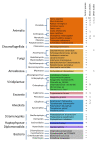Remodeling Cildb, a popular database for cilia and links for ciliopathies
- PMID: 25422781
- PMCID: PMC4242763
- DOI: 10.1186/2046-2530-3-9
Remodeling Cildb, a popular database for cilia and links for ciliopathies
Abstract
Background: New generation technologies in cell and molecular biology generate large amounts of data hard to exploit for individual proteins. This is particularly true for ciliary and centrosomal research. Cildb is a multi-species knowledgebase gathering high throughput studies, which allows advanced searches to identify proteins involved in centrosome, basal body or cilia biogenesis, composition and function. Combined to localization of genetic diseases on human chromosomes given by OMIM links, candidate ciliopathy proteins can be compiled through Cildb searches.
Methods: Othology between recent versions of the whole proteomes was computed using Inparanoid and ciliary high throughput studies were remapped on these recent versions.
Results: Due to constant evolution of the ciliary and centrosomal field, Cildb has been recently upgraded twice, with new species whole proteomes and new ciliary studies, and the latter version displays a novel BioMart interface, much more intuitive than the previous ones.
Conclusions: This already popular database is designed now for easier use and is up to date in regard to high throughput ciliary studies.
Figures


Similar articles
-
Cildb: a knowledgebase for centrosomes and cilia.Database (Oxford). 2009;2009:bap022. doi: 10.1093/database/bap022. Epub 2009 Dec 7. Database (Oxford). 2009. PMID: 20428338 Free PMC article.
-
Insights into Ciliary Genes and Evolution from Multi-Level Phylogenetic Profiling.Mol Biol Evol. 2017 Aug 1;34(8):2016-2034. doi: 10.1093/molbev/msx146. Mol Biol Evol. 2017. PMID: 28460059 Free PMC article.
-
Targeting of ASH Domain-Containing Proteins to the Centrosome.Methods Mol Biol. 2016;1454:15-33. doi: 10.1007/978-1-4939-3789-9_2. Methods Mol Biol. 2016. PMID: 27514913
-
Ciliopathies and DNA damage: an emerging nexus.Curr Opin Nephrol Hypertens. 2015 Jul;24(4):366-70. doi: 10.1097/MNH.0000000000000134. Curr Opin Nephrol Hypertens. 2015. PMID: 26050124 Review.
-
Motile and non-motile cilia in human pathology: from function to phenotypes.J Pathol. 2017 Jan;241(2):294-309. doi: 10.1002/path.4843. J Pathol. 2017. PMID: 27859258 Review.
Cited by
-
An Expanded Role for the RFX Transcription Factor DAF-19, with Dual Functions in Ciliated and Nonciliated Neurons.Genetics. 2018 Mar;208(3):1083-1097. doi: 10.1534/genetics.117.300571. Epub 2018 Jan 3. Genetics. 2018. PMID: 29301909 Free PMC article.
-
Paramecium tetraurelia basal body structure.Cilia. 2016 Feb 8;5:6. doi: 10.1186/s13630-016-0026-4. eCollection 2015. Cilia. 2016. PMID: 26862393 Free PMC article. Review.
-
An updated SYSCILIA gold standard (SCGSv2) of known ciliary genes, revealing the vast progress that has been made in the cilia research field.Mol Biol Cell. 2021 Dec 1;32(22):br13. doi: 10.1091/mbc.E21-05-0226. Epub 2021 Oct 6. Mol Biol Cell. 2021. PMID: 34613793 Free PMC article. Review.
-
The BioMart community portal: an innovative alternative to large, centralized data repositories.Nucleic Acids Res. 2015 Jul 1;43(W1):W589-98. doi: 10.1093/nar/gkv350. Epub 2015 Apr 20. Nucleic Acids Res. 2015. PMID: 25897122 Free PMC article.
-
SCAPER localizes to primary cilia and its mutation affects cilia length, causing Bardet-Biedl syndrome.Eur J Hum Genet. 2019 Jun;27(6):928-940. doi: 10.1038/s41431-019-0347-z. Epub 2019 Feb 5. Eur J Hum Genet. 2019. PMID: 30723319 Free PMC article. Clinical Trial.
References
LinkOut - more resources
Full Text Sources
Other Literature Sources

